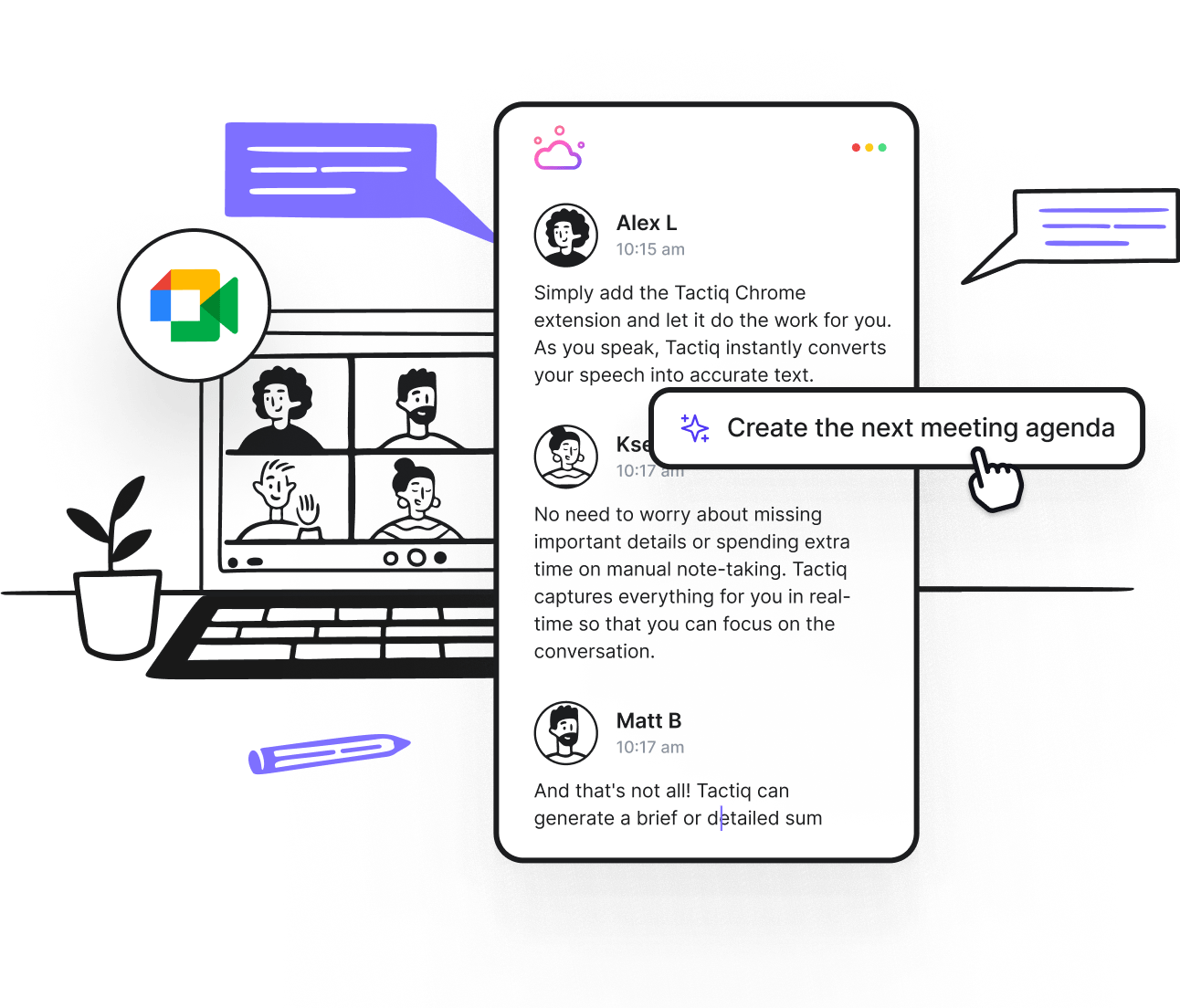How to Block and Unblock Users on Google Meet
July 18, 2024
July 18, 2024
August 20, 2025
August 20, 2025
Managing your Google Meet sessions effectively is crucial for productive meetings. Sometimes, it's necessary to block certain participants to prevent disruptions, safeguard sensitive information, and ensure a smooth meeting experience. Knowing how to block and unblock users on Google Meet can help you maintain control and focus during your online interactions.
This guide will walk you through the steps to manage your participant list to enhance the security and efficiency of your virtual meetings.
Why Might You Block Someone on Google Meet

Sometimes, you may need to block someone on Google Meet to ensure smooth and productive meetings. Blocking helps control who can join and interact during video calls. It’s a useful feature for maintaining a professional and secure environment.
Common Reasons for Blocking Users
Blocking users on Google Meet can happen for various reasons:
- Disruptive Behavior: If someone constantly interrupts or derails the meeting, blocking might be necessary.
- Uninvited Guests: Sometimes, people who aren't supposed to join might find their way into your meeting.
- Spamming the Chat: Excessive, irrelevant messages can distract participants.
- Offensive Language or Actions: Any form of harassment or inappropriate behavior.
Impact of Blocked Users on Meetings
Blocked users can negatively affect your meetings:
- Loss of Focus: Constant interruptions can make it hard to stay on topic.
- Reduced Participation: Other participants might feel uncomfortable and less likely to contribute.
- Time Wasting: Addressing disruptions takes time away from important discussions.
- Professionalism: Uninvited guests can make your meeting seem unprofessional.
Privacy and Security Concerns
Blocking helps protect your privacy and security:
- Sensitive Information: Meetings often involve sharing confidential information. Blocking ensures that only trusted participants have access.
- Data Protection: Prevent uninvited guests from accessing private data.
- Personal Safety: Avoid potential harassment or stalking by controlling who can see and interact with you.
Examples of Disruptive Behaviors
Understanding specific disruptive behaviors can help you decide when to block someone:
- Interrupting Speakers: Frequent, unnecessary interruptions can derail the meeting.
- Unwanted Screen Sharing: Participants sharing irrelevant content can disrupt the flow.
- Background Noise: Loud or distracting noise from a participant’s environment.
- Ignoring Meeting Rules: Not following the set agenda or guidelines.
Using these guidelines, you can manage your Google Meet sessions more effectively.
What Happens When You Block Someone on Google Meet?
Blocking someone on Google Meet involves several key changes. Understanding these changes helps you manage your meetings better and ensures a smooth experience for all participants.
Effects on the Blocked User
When you block someone on Google Meet, several things happen to the blocked user:
- Loss of Access: The blocked user can't join your meetings or see your meeting invites.
- Communication Restrictions: Direct communication through Google Meet is cut off. They can’t message you or call you in the app.
- Profile Visibility: Your profile will not appear in their contacts or meeting lists.
Notification and Confirmation Prompts
Google Meet offers clear prompts to ensure you are aware of blocking actions:
- Notification: The system sends you a notification when you attempt to block someone, ensuring you confirm this action.
- Confirmation Prompt: A pop-up appears asking you to confirm before the block is finalized. This step prevents accidental blocking.
Understanding these aspects ensures you use the blocking feature effectively, maintaining control over your Google Meet interactions.
How to Block Someone on Google Meet
Blocking someone on Google Meet ensures that they cannot contact you directly or disrupt your meetings. Follow these steps to block a user:
- Sign in to Google Meet: Go to meet.google.com/calling/ on your computer and sign in with your Google account.
- Locate the Contact: Under "Recent Activity," find and click on the contact you wish to block.
- Access Options: Click on the "Options" button next to the contact’s name.
- Select Block User: Choose "Block user" from the menu.

- Report as Spam (Optional): If necessary, check the box to "Report as spam."
- Confirm Blocking: Click "Report abuse & block" if you are reporting abuse, or simply click "Block" to finalize the action without reporting.
By following these steps, you can maintain a more controlled and productive meeting environment.
How to Unblock Someone on Google Meet
If you've blocked someone on Google Meet and now need to unblock them, following these steps will help you restore communication quickly:
- Open Google Meet: Start by logging into your Google Meet account.
- Access Settings: Click on the gear icon, usually located at the top right corner of the screen.
- Navigate to Blocked Users: In the settings menu, find the section labeled 'Blocked Users’.
- Locate the User: Scroll through the list to find the user you want to unblock.
- Select Unblock: Click the 'Unblock' button next to their name.

Accessing Blocked User Settings
To manage blocked users, you need to know where to find these settings:
- Login to Google Meet: Ensure you are logged into your account.
- Settings Icon: Look for the gear icon in the top right corner and click on it.
- Blocked Users Section: Within the settings menu, there is a specific section for managing blocked users. This section lists all users you have blocked.
Troubleshooting Common Issues
Sometimes, unblocking may not go as smoothly as expected. Here are common issues and their solutions:
- User Not Appearing in Blocked List: If the user you want to unblock isn’t showing, check if they were blocked on another Google service like Google Contacts or Google Chat.
- Changes Not Syncing: Ensure your internet connection is stable. Refresh the page or restart Google Meet to sync changes.
- Unblock Button Not Working: This could be a browser issue. Try clearing your browser cache or accessing Google Meet from a different browser.
By following these steps, you can easily unblock someone on Google Meet and resume your interactions without any hurdles.
How to Unblock a Google Contact
Unblocking someone on Google Meet might not be enough if they are also blocked in your Google Contacts. Follow these steps to ensure the contact is fully unblocked across all Google services.
Using the Google Contacts App
To begin, you need to access the Google Contacts app:
- Open the App: Launch the Google Contacts app on your device. If you don't have it, you can download it from the Google Play Store or the App Store.
- Login: Make sure you are logged in with the same Google account you use for Google Meet.
Navigating to Blocked Numbers
Once you are in the app, locate the blocked numbers:
- Menu Access: Tap on the menu icon, which looks like three horizontal lines or dots, usually found at the top left or right corner.
- Settings: Scroll down and select 'Contact Settings' from the menu.
- Blocked Numbers: In the settings, find and tap on 'Blocked numbers' to see a list of all the contacts you have blocked.
Removing a Contact from the Blocked List
Now, unblock the contact:
- Locate the Contact: Scroll through the list to find the contact you wish to unblock.
- Unblock: Tap on the contact’s name and then tap the 'Unblock' button next to it. This action will immediately remove the contact from your blocked list.
Synchronizing Changes Across Devices
Finally, ensure the changes are reflected on all your devices:
- Refresh Sync: After unblocking the contact, it is crucial to sync your Google Contacts. Go to your device's settings, select 'Accounts,' then 'Google,' and ensure that 'Contacts' sync is turned on.
- Manual Sync: If automatic sync does not update right away, you can force a manual sync by tapping 'Sync now' in the account settings.
By following these steps, you ensure that the unblocked contact is accessible across all Google services, including Google Meet. This process helps maintain seamless communication and avoids any disruptions caused by blocked contacts.
How to Block and Unblock Someone on Google Chat
Blocking and unblocking someone on Google Chat requires a few straightforward steps. This section will guide you through the process, ensuring you can manage your contacts effectively.
Steps to Block a Contact in Google Chat
Blocking a contact prevents them from sending you messages. Here’s how to do it:
- Access Google Chat: Open Google Chat from your device or via the web.
- Select the Conversation: Find and open the chat with the person you want to block.
- Access Options: Tap on the contact’s name at the top of the screen.
- Block: Choose 'Block & Report' from the dropdown menu. Confirm your decision in the prompt that appears.

Managing Blocked Contacts in the Conversation Settings
After blocking someone, you might want to manage or review your blocked contacts:
- Settings Access: Open Google Chat and go to the settings by clicking the gear icon.
- Blocked Contacts: Navigate to 'Blocked users’ then select ‘Manage blocked users’ to see a list of all the people you’ve blocked.
- Review and Edit: From here, you can review the list and decide if you want to keep any contacts blocked or unblock them.
Unblocking a Contact and Restoring Communication
If you decide to unblock a contact, follow these steps:
- Open Settings: Access the settings menu in Google Chat.
- Blocked Contacts List: Find the 'Blocked contacts' section.
- Select and Unblock: Locate the contact you want to unblock. Click on the ‘X’ next to their name. This action will restore communication with the contact.
Differences Between Google Chat and Google Meet Blocking
Blocking in Google Chat and Google Meet affects interactions differently:
- Google Chat: Blocking a contact stops all messaging and notifications from that person. You won’t receive any messages, and they won’t be able to see your status or interact with you in shared spaces.
- Google Meet: Blocking someone in Google Meet prevents them from joining your meetings and sending you invites. However, it does not stop them from messaging you unless they are also blocked in Google Chat.
Understanding these differences ensures you manage your privacy effectively across Google services. This knowledge allows you to maintain control over your interactions and ensures a seamless experience in both Google Chat and Google Meet.
{{rt_cta_ai-convenience}}
How Tactiq Can Help with Google Meet Management

Tactiq is a tool designed to enhance your Google Meet experience by providing features that improve productivity and participant management. Here’s how Tactiq makes your meetings more effective:
Automatic Notetaking and Transcription Features
Tactiq offers automatic notetaking and transcription, saving you the hassle of manual documentation:
- Real-time Transcription: Tactiq captures everything said during the meeting in real-time, ensuring you don't miss any details.
- Highlights and Key Points: The tool allows you to highlight important parts of the conversation, making it easier to review later.
- Searchable Transcripts: All transcriptions are searchable, so you can quickly find specific information when needed.
Enhancing Meeting Productivity with Tactiq
Tactiq boosts your meeting productivity by automating several tasks:
- Action Items: It identifies and records action items during the meeting, allowing you to focus on the conversation.
- Follow-Up Reminders: Tactiq sends reminders for follow-up tasks, ensuring nothing falls through the cracks.
- Collaboration: The tool makes it easy to share notes and summaries with team members, enhancing collaboration.
Real-Time Insights and Summaries During Meetings
Tactiq offers real-time insights and summaries, helping you stay on top of the meeting's progress:
- Live Summaries: Receive live summaries of the discussion, keeping you informed without needing to review long transcripts.
- Meeting Metrics: Access metrics like speaking time and participation levels, which can help you identify areas for improvement.
- Instant Feedback: Gather instant feedback from participants through integrated tools, fostering a more interactive and engaging meeting environment.
These features make Tactiq a powerful tool for managing Google Meet sessions, ensuring you capture every detail and maintain effective communication with your team.
Ensuring Effective Participant Management in Google Meet
Effectively managing participants in Google Meet is essential for productive, professional meetings. Blocking and unblocking users helps maintain control, safeguard information, and ensure smooth interactions. Blocking addresses disruptive behavior, uninvited guests, and spam, protecting sensitive data, and maintaining professionalism.
Understanding the impacts of blocking ensures wise use of this feature. Unblocking is straightforward, allowing quick restoration of communication. Managing blocked users across Google Meet, Contacts, and Chat ensures seamless interactions.
Leveraging tools like Tactiq enhances your experience with real-time transcription, automatic note-taking, and actionable insights. Mastering these techniques ensures your Google Meet sessions are secure, professional, and productive. Download Tactiq for free today.
Blocking someone on Google Meet helps you prevent disruptions, protect sensitive information, and maintain a professional meeting environment. You stay focused and productive by controlling who can join and interact during your sessions.
When you block a user, they lose access to your meetings, can't see your invites, and can't contact you through Google Meet. This ensures your meetings remain secure and free from unwanted interruptions.
To block, sign in to Google Meet, find the contact under 'Recent Activity,' click 'Options,' select 'Block user,' and confirm. To unblock, go to settings, find 'Blocked Users,' locate the person, and click 'Unblock'—restoring communication quickly.
If unblocking fails, check if the person is also blocked in Google Contacts or Google Chat. Refresh your browser, ensure your internet connection is stable, or try a different browser to resolve syncing issues.
Tactiq provides real-time transcription, automatic note-taking, and actionable meeting insights, so you never miss important details. You save time, boost productivity, and keep meetings organized without manual effort.
Want the convenience of AI summaries?
Try Tactiq for your upcoming meeting.
Want the convenience of AI summaries?
Try Tactiq for your upcoming meeting.
Want the convenience of AI summaries?
Try Tactiq for your upcoming meeting.


_Main.jpg)






